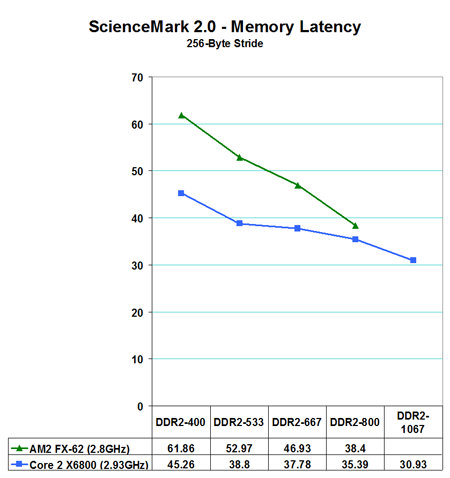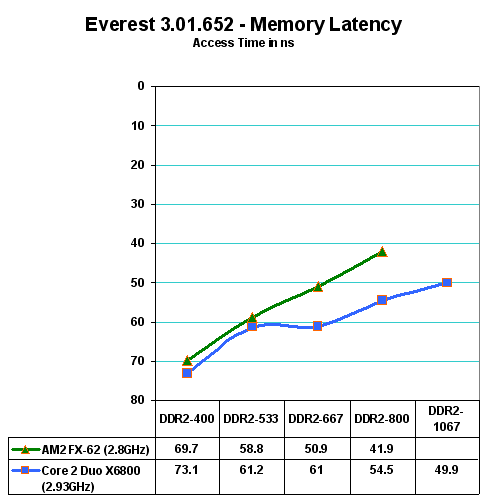A Closer Look at Latency and Scaling
As was explained in the Core 2 Duo launch review, Core 2 Duo has not physically added a memory controller on the processor. The memory controller is still part of the motherboard chipset that drives Core 2 Duo. Intel added features that perform intelligent look-aheads on the memory controller to behave like lower latency. As you saw on pages 2 and 3, ScienceMark 2.0 shows the "intelligent look-aheads" in Core 2 Duo to be extremely effective, with Core 2 Duo memory now exhibiting lower apparent latency than AM2. However, not all latency benchmarks show the same results. Everest from Lavalys shows latency improvements in the new CPU revisions, but it shows Latency more as we would expect in evaluating Conroe. For that reason, our detailed benchmarks for latency will use both Everest 1.51.195, which fully supports the Core 2 Duo processor, and ScienceMark 2.0.
Latency, or how fast memory is accessed, is not a static measurement. It varies with memory speed and generally improves (goes down) as memory speed increases. To better understand what is happening with memory accesses we first looked at Sciencemark 2.0 Latency on both AM2 and Conroe.

ScienceMark shows Conroe Latency with a 45ns to 61ns lead at DDR2-400. Latency continues to decrease as memory speed increases with Core 2 Duo, reaching a value of about 30ns at DDR2-1067. The Trend line for AM2 is steeper than Core 2 Duo, increasing at a rapid rate until latency is virtually the same at DDR2-800.
It is very interesting that ScienceMark shows lower latency on Core 2 Duo than AM2, since we all know the on-chip AM2 controller has to be faster. We thought perhaps it was because all of the tested memory accesses could be contained in the shared 4MB cache of Core 2 Duo, but Alex Goodrich,one of the authors of ScienceMark, states that Version 2 is designed to test up to 16MB of memory, forseeing the day of larger caches. In addition he states the Core 2 duo prefetcher is clever enough to pick up all the patterns ScienceMark uses to "fool" hardware prefetchers. ScienceMark plans a revision with an algoritm that is harder to fool, but Alex commented that Conroe fooling their benchmark was "in itself a great indicator of performance".

Everest uses a different algorithm for measuring Latency, and it shows the on-chip AM2 DDR2 controller in the lead at all memory speeds, with Latency almost the same at the Core 2 Duo memory speed range of DDR2-400 to DDR2-533. However, the Everest trend lines are similar to those in ScienceMark, in that AM2 latency improves at a steeper rate than Core 2 Duo as memory speed increases.
The point to the Latency discussion is that, as expected, AMD has much more opportunity for performance improvement with memory speed increases in AM2. Intel will eventually reach the point, if the lines were extended, where they would have to move to an on-chip memory controller to further improve latency. This is not to take anything away from Intel's intelligent design on Core 2 Duo. They have found a solution that fixes a performance issue without requiring an on-chip controller - for now.
As was explained in the Core 2 Duo launch review, Core 2 Duo has not physically added a memory controller on the processor. The memory controller is still part of the motherboard chipset that drives Core 2 Duo. Intel added features that perform intelligent look-aheads on the memory controller to behave like lower latency. As you saw on pages 2 and 3, ScienceMark 2.0 shows the "intelligent look-aheads" in Core 2 Duo to be extremely effective, with Core 2 Duo memory now exhibiting lower apparent latency than AM2. However, not all latency benchmarks show the same results. Everest from Lavalys shows latency improvements in the new CPU revisions, but it shows Latency more as we would expect in evaluating Conroe. For that reason, our detailed benchmarks for latency will use both Everest 1.51.195, which fully supports the Core 2 Duo processor, and ScienceMark 2.0.
Latency, or how fast memory is accessed, is not a static measurement. It varies with memory speed and generally improves (goes down) as memory speed increases. To better understand what is happening with memory accesses we first looked at Sciencemark 2.0 Latency on both AM2 and Conroe.

ScienceMark shows Conroe Latency with a 45ns to 61ns lead at DDR2-400. Latency continues to decrease as memory speed increases with Core 2 Duo, reaching a value of about 30ns at DDR2-1067. The Trend line for AM2 is steeper than Core 2 Duo, increasing at a rapid rate until latency is virtually the same at DDR2-800.
It is very interesting that ScienceMark shows lower latency on Core 2 Duo than AM2, since we all know the on-chip AM2 controller has to be faster. We thought perhaps it was because all of the tested memory accesses could be contained in the shared 4MB cache of Core 2 Duo, but Alex Goodrich,one of the authors of ScienceMark, states that Version 2 is designed to test up to 16MB of memory, forseeing the day of larger caches. In addition he states the Core 2 duo prefetcher is clever enough to pick up all the patterns ScienceMark uses to "fool" hardware prefetchers. ScienceMark plans a revision with an algoritm that is harder to fool, but Alex commented that Conroe fooling their benchmark was "in itself a great indicator of performance".

Everest uses a different algorithm for measuring Latency, and it shows the on-chip AM2 DDR2 controller in the lead at all memory speeds, with Latency almost the same at the Core 2 Duo memory speed range of DDR2-400 to DDR2-533. However, the Everest trend lines are similar to those in ScienceMark, in that AM2 latency improves at a steeper rate than Core 2 Duo as memory speed increases.
The point to the Latency discussion is that, as expected, AMD has much more opportunity for performance improvement with memory speed increases in AM2. Intel will eventually reach the point, if the lines were extended, where they would have to move to an on-chip memory controller to further improve latency. This is not to take anything away from Intel's intelligent design on Core 2 Duo. They have found a solution that fixes a performance issue without requiring an on-chip controller - for now.










118 Comments
View All Comments
HSuke - Thursday, July 27, 2006 - link
I hope this means that you're going to do the tests on the Core 2 Duo test platform IN ADDITION to your current platforms.
I hope this does NOT mean that you're going to do the tests EXCLUSIVELY on the Core 2 Duo test platform.
So are you going to stop doing memory tests with AMD processors? How scientific is that? If you go to page 7 and look at the performance charts, you'll see that memory speeds have a much greater impact (pertage-wise) on the AMD setup than the Core 2 Duo setup.
Well, I'm quite surprised that memory even made a difference. But since that is true (according to your tests), shouldn't be testing on AM2 instead of Core 2 Duo processors in the future because the difference is more marked? If there wasn't any significant difference on an Intel system, but a significant difference on an AMD system, you'd probably suggest that memory doesn't make a difference, commiting a type 2 error.
Now, I don't care about memory. I always buy whatever is on sale. But making that conclusion would just piss off so many memory enthusiasts and memory sellers. And aren't those guys the ones that would be reading this article?
Think about it.
Wesley Fink - Friday, July 28, 2006 - link
As we explained in the article, AM2 currently does not support the DDR2-1067 speed, while the Intel chipset for Core 2 Duo DOES support 1067. Since most memory we test can reach 900 to 1067 or 1100 or greater the 1067 ratio is an advantage. Also the current AM2 memory controller does not support settings of 2 for Ras-to-Cas or tRef - AM2 only supports to 3. Core 2 Dupo supports faster timings of 2 at these settings. Since these lower settings are often usable in fast memory they can be very important.For these reasons, we will be using the Core 2 Duo platform for testing DDR2 memory, since we can test more of the options that are available and may be important on high-performance DDR2 memory. If and when AM2 upgrades their DDR2 memory controller we will reconsider testing on AM2.
Kiijibari - Wednesday, July 26, 2006 - link
Hi everybody,first of all I have to admit that this is the best Anandtech article for a long time. Everybody blamed me for being an AMD fanboy latley, however I do not have any problems to admit that Core2 is faster.
If Intel would not have anything faster than AMD after 3 years of AMD lead, Intel would be best adwised to stop making CPUs and become an AMD chipset company ;-)
I have one question left: Which BIOS version did you use with the AM2 board ?
I recoginzed that DDR2 bandwidth scores increased quiet much compared to the initial tests. Now we have Sandra scores around 9.3 GB/s, however I remember that the initial ones were around 7.4 GB/s max.
In conclusion I assume that there is some optimization going on, due to bios seetings.
There was also a little test over at lostcircuits:
http://www.lostcircuits.com/motherboard/foxconn_c5...">http://www.lostcircuits.com/motherboard/foxconn_c5...
There the Asus board scored just ~7 GB/s, but a tested Foxconn board is again in the 9GB/s area.
It maybe that the BIOSes are optimized for different kind of RAMs, too, as lostcircuit used OCZ memory, not Corsair.
Anyways, I think the results are interesting enough to dig a little bit further ;-)
Thanks again for the great review.
regards
Kiijibari
Wesley Fink - Wednesday, July 26, 2006 - link
P5W-DH Deluxe BIOS is 701, dated 7/08/2006. The Corsair memory used in this review can do 4-3-4-11 timings at DDR2-1067, where most high-end DDR2 can only reach 4-4-4 timings at that speed.Kiijibari - Wednesday, July 26, 2006 - link
Sorry, looks like you misunderstood me, I was wondering about the AM2 platform bandwidth results @2.8Ghz and DDR2-800(page3). The Core2 scores are the same as "usual" ;-)So can you also say which bios you were using for the Asus M2N32-SLI ?
thanks a lot
Kiijibari
Gary Key - Thursday, July 27, 2006 - link
0603 - 6/29/06
OcHungry - Wednesday, July 26, 2006 - link
But I dont understand why you need DDR2 800 or 1000?DDR2 667 w/ tighter timings can run @ 333 1:1 ratio (333x9 for FX62).
Tell me what I am missing here?
zsdersw - Thursday, July 27, 2006 - link
Understatement of the year.
zsdersw - Wednesday, July 26, 2006 - link
Interesting notion. If it ever came to be, you can kiss price cuts (and innovation) on AMD chips goodbye.
Shizen - Tuesday, July 25, 2006 - link
Intel Core 2 comes out and AMD slashes prices across the board... the months ahead look like a great time to buy a new rig! Finally, I can retire my aging 2.8GHz Northwood and move on to PCI-E and DDR2. *_*Many thanks to the AnandTech dudes for keeping us abreast with the CPU wars, and I personally hope you guys come out with more articles geared for the midranged ($1000-$1500) buyer.
Yeah, I like the idea of being a PERFORMANCE fanboi rather than a brand-centric one. o_o